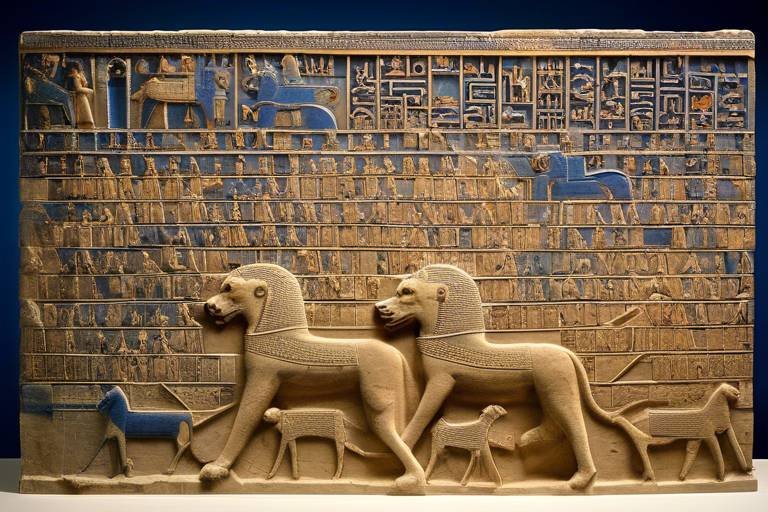The Mysterious Artifacts of the Antikythera Mechanism
Have you ever heard of a device so advanced that it baffled researchers for centuries? The Antikythera Mechanism is a true enigma, a marvel of ancient Greek engineering that continues to astound and intrigue us to this day. Discovered by sponge divers in 1901 off the coast of the Greek island of Antikythera, this mysterious artifact has sparked countless questions about its origin, purpose, and significance.
Imagine a world where ancient astronomers could predict eclipses, track celestial events, and unravel the mysteries of the cosmos with astonishing accuracy. The Antikythera Mechanism was no ordinary device; it was a sophisticated analog computer that revolutionized our understanding of ancient technology and astronomy. Its intricate gears and mechanisms showcase the advanced engineering skills of its creators, leaving modern researchers in awe of its complexity.
Some believe that the Antikythera Mechanism served as an astronomical calculator, allowing its users to make precise calculations related to the movements of the planets and stars. Others speculate that it might have been used as an educational tool to teach students about the wonders of the universe. Perhaps it even functioned as a status symbol for the elite of ancient Greece, showcasing their wealth and knowledge to the world.
What sets the Antikythera Mechanism apart from other ancient artifacts is its technological innovation. The device utilized differential gears, a groundbreaking feature that was centuries ahead of its time. This innovation not only highlights the ingenuity of its creators but also raises questions about the level of technological advancement in ancient Greece that we have yet to fully comprehend.
One of the greatest challenges in studying the Antikythera Mechanism lies in deciphering the inscriptions found on its surface. These inscriptions contain valuable clues about the device's creators and users, shedding light on the society that produced such a remarkable piece of technology. However, translating and interpreting these inscriptions is no easy task, requiring a deep understanding of ancient Greek language and culture.
The legacy of the Antikythera Mechanism extends far beyond its discovery. This ancient artifact has had a profound impact on modern technology and our understanding of ancient Greek science. It continues to inspire researchers and innovators to push the boundaries of knowledge, sparking new discoveries and advancements in the field of archaeology and astronomy.
As ongoing research and projects focus on unraveling the mysteries of the Antikythera Mechanism, we can only imagine the potential for new revelations and insights into this fascinating artifact. The journey to uncover the secrets of this ancient Greek analog computer is far from over, and the possibilities for future discoveries are endless.
- What is the Antikythera Mechanism?
- What was the purpose of the Antikythera Mechanism?
- How advanced was the technology used in the Antikythera Mechanism?
- What do the inscriptions on the Antikythera Mechanism reveal?
- How has the Antikythera Mechanism influenced modern technology?
The Antikythera Mechanism is an ancient Greek analog computer that was discovered in 1901 off the coast of the Greek island of Antikythera. It is considered one of the most important archaeological finds of the 20th century.
The purpose of the Antikythera Mechanism is still a subject of debate among researchers. Some believe it was used for astronomical calculations, while others think it served as an educational tool or a status symbol.
The Antikythera Mechanism was incredibly advanced for its time, utilizing differential gears that were not seen in other devices until many centuries later. This level of technological innovation has puzzled historians and archaeologists.
The inscriptions on the Antikythera Mechanism provide valuable insights into the device's creators and users. However, translating and interpreting these inscriptions is a complex task that requires a deep understanding of ancient Greek language and culture.
The Antikythera Mechanism has had a significant impact on modern technology, inspiring researchers and scientists to explore new avenues of research in archaeology and astronomy. Its legacy continues to shape our understanding of ancient Greek science.

Discovery of the Antikythera Mechanism
Exploring the enigmatic Antikythera Mechanism, an ancient Greek analog computer, and its significance in understanding ancient technology and astronomy, shedding light on the mysteries of its origin and purpose.
Uncovering the fascinating story of how the Antikythera Mechanism was discovered by sponge divers off the coast of the Greek island of Antikythera in 1901.
The discovery of the Antikythera Mechanism was nothing short of a serendipitous event, a stroke of luck that unveiled a hidden treasure from the depths of the sea. Imagine the awe and wonder that must have filled the hearts of those divers as they stumbled upon this ancient marvel, lost to time and buried beneath the waves. The sunken shipwreck revealed its secrets slowly, piece by piece, until the intricate gears and mechanisms of the Antikythera device emerged, a testament to the ingenuity of ancient craftsmanship.
As the divers brought the fragments of the mechanism to the surface, they unknowingly unearthed a mystery that would captivate the minds of scholars and historians for generations to come. The Antikythera Mechanism, with its intricate system of gears and dials, hinted at a level of technological sophistication far beyond what was believed possible in ancient times. The discovery sparked a renewed interest in ancient Greek science and technology, challenging our perceptions of the past and opening doors to new avenues of exploration.
Today, the Antikythera Mechanism stands as a symbol of human ingenuity and curiosity, a tangible link to a civilization long gone yet still speaking to us through its intricate design and complex functions. Its discovery remains a testament to the power of exploration and the enduring allure of uncovering the secrets of the past.

Structure and Complexity
The Antikythera Mechanism, a marvel of ancient engineering, astounds researchers with its intricate structure and complexity. Comprised of a series of finely crafted gears and components, this ancient Greek analog computer presents a formidable challenge to modern scholars seeking to unravel its secrets. The sheer intricacy of its design hints at a level of technological sophistication far ahead of its time, leaving experts in awe of the craftsmanship involved in its creation.
Upon closer inspection, the Antikythera Mechanism reveals a level of complexity that surpasses expectations. The precise alignment of its gears and the intricately interconnected mechanisms speak to a level of engineering prowess that defies conventional wisdom about ancient technology. Researchers are faced with the daunting task of deciphering the purpose behind each gear and cog, unraveling the mysteries of a device that continues to astound and perplex even centuries after its discovery.
Examining the inner workings of the Antikythera Mechanism is akin to unraveling a complex puzzle where each piece plays a crucial role in the overall function of the device. The interplay of gears, dials, and indicators suggests a level of sophistication that challenges our understanding of ancient technology. As researchers delve deeper into its structure, they are met with a web of intricacies that hint at a level of complexity previously unseen in artifacts of its time.

Astronomical Functions
The Antikythera Mechanism, often dubbed as the world's oldest analog computer, showcases remarkable astronomical functions that astound researchers and historians alike. This ancient marvel is not merely a mechanical device but a testament to the advanced knowledge of the ancient Greeks in the realm of astronomy.
One of the most intriguing capabilities of the Antikythera Mechanism is its ability to predict eclipses with astonishing accuracy. By manipulating its intricate system of gears and dials, ancient users could foresee the occurrence of both solar and lunar eclipses, a feat that demonstrates a profound understanding of celestial movements.
Furthermore, this extraordinary device was designed to track celestial events such as the positions of the sun, moon, and planets in the sky. By aligning specific pointers and indicators on the mechanism, users could observe the movements of these celestial bodies and anticipate astronomical phenomena with precision.
Moreover, the Antikythera Mechanism serves as a tangible representation of the ancient Greeks' conceptualization of the cosmos. Through its intricate design and astronomical functions, it provides insights into how ancient astronomers perceived the universe and sought to comprehend the mysteries of the night sky.
In essence, the astronomical functions of the Antikythera Mechanism transcend mere mechanical ingenuity; they reflect a profound connection between ancient technology and the study of the cosmos. This enigmatic artifact continues to captivate modern audiences with its celestial capabilities and serves as a window into the sophisticated astronomical knowledge of ancient civilizations.

Purpose and Use
When it comes to the purpose and use of the Antikythera Mechanism, one can't help but marvel at the possibilities that this ancient device may have served. While its exact function remains a subject of debate among historians and archaeologists, several theories have emerged to shed light on its potential roles in ancient Greek society.
Some experts suggest that the Antikythera Mechanism could have been utilized as an astronomical calculator, aiding in the prediction of celestial events such as eclipses and planetary movements. This theory aligns with the intricate gear system and astronomical dials found within the device, pointing towards its significance in tracking and understanding the cosmos.
Another viewpoint proposes that the mechanism might have served as an educational tool, allowing scholars and students to study and learn about the movements of the stars and planets. Imagine ancient Greek astronomers using this sophisticated device to teach the principles of astronomy, unraveling the mysteries of the universe.
Furthermore, some researchers speculate that the Antikythera Mechanism could have functioned as a status symbol for the elite and affluent individuals of ancient Greece. Owning such a technologically advanced device would have not only showcased one's wealth but also demonstrated a deep appreciation for science and innovation.
Considering the complexity and precision of the Antikythera Mechanism, it is evident that its purpose likely encompassed a combination of these roles, serving as a multifaceted instrument that bridged the worlds of technology, astronomy, and societal status in ancient times.

Technological Innovation
When it comes to technological innovation, the Antikythera Mechanism stands out as a marvel of ancient engineering prowess. This intricate device, with its complex system of gears and dials, showcases a level of technological sophistication that was previously unimaginable for its time. Imagine the astonishment of modern researchers as they unraveled the mysteries of this ancient analog computer, marveling at the precision and ingenuity embedded in its design.
One of the most remarkable features of the Antikythera Mechanism is its use of differential gears, a technological innovation that was far ahead of its time. These gears allowed the device to perform intricate calculations and track celestial movements with remarkable accuracy. The presence of such advanced technology challenges our preconceptions about the capabilities of ancient civilizations and raises questions about the sources of their knowledge and expertise.
Moreover, the existence of the Antikythera Mechanism has profound implications for the history of technology. It serves as a testament to the ingenuity and inventiveness of ancient engineers, pushing the boundaries of what was thought possible in the ancient world. The discovery of this ancient analog computer forces us to reevaluate our understanding of technological progress and innovation, prompting us to consider the possibility of lost technologies and ancient achievements waiting to be uncovered.

Deciphering the Inscriptions
Deciphering the inscriptions on the Antikythera Mechanism presents a unique challenge to researchers due to the intricate nature of the text and the limited amount of surviving inscriptions. The text, written in ancient Greek, provides valuable clues to the origins and purpose of this mysterious device. Scholars have painstakingly analyzed the inscriptions, which include descriptions of celestial events and references to astronomical concepts, in an effort to unravel the secrets encoded within the mechanism.
One of the key difficulties in deciphering the inscriptions lies in the fragmented nature of the text, with many sections missing or damaged over time. Researchers have used advanced imaging techniques, such as X-ray scanning and 3D modeling, to reconstruct the inscriptions and gain a better understanding of the information they contain. By piecing together the scattered fragments of text, experts have been able to decipher some of the ancient Greek phrases and symbols engraved on the device.
The inscriptions on the Antikythera Mechanism provide insights into the astronomical knowledge of the ancient Greeks and their sophisticated understanding of celestial phenomena. References to planetary movements, eclipses, and zodiacal signs suggest that the device was used for tracking and predicting astronomical events. The detailed inscriptions serve as a testament to the advanced scientific capabilities of the ancient Greek civilization and highlight the importance of astronomy in their culture.
Despite the challenges posed by the ancient inscriptions, researchers have made significant progress in deciphering the text and unlocking the mysteries of the Antikythera Mechanism. By combining linguistic analysis with archaeological findings, experts have been able to piece together the meanings behind the inscriptions and shed light on the purpose and function of this remarkable ancient device. The inscriptions continue to be a subject of ongoing study and debate among scholars seeking to unravel the secrets of this enigmatic artifact.

Legacy and Influence
When it comes to the legacy and influence of the Antikythera Mechanism, one cannot underestimate its profound impact on both ancient and modern societies. This remarkable artifact not only serves as a testament to the ingenuity of ancient Greek craftsmanship but also continues to inspire awe and curiosity in the field of archaeology and technology.
The Antikythera Mechanism's influence extends beyond its physical structure, reaching into the realms of science, history, and innovation. By revealing the advanced knowledge of astronomy possessed by the ancient Greeks, this device has reshaped our understanding of their intellectual capabilities and technological achievements.
Furthermore, the Antikythera Mechanism has left a lasting imprint on the development of modern technology. Its intricate gears and mechanisms have sparked new ideas and innovations in the design of mechanical devices, serving as a source of inspiration for engineers and inventors seeking to push the boundaries of what is possible.
Moreover, the Antikythera Mechanism's legacy can be seen in its role as a cultural icon, symbolizing the intersection of art, science, and history. Its mysterious origins and complex functions have captured the imagination of people around the world, turning it into a symbol of human curiosity and the relentless pursuit of knowledge.
In conclusion, the legacy and influence of the Antikythera Mechanism are far-reaching and multifaceted, embodying the enduring impact of ancient technology on our modern world. As we continue to uncover its secrets and unravel its mysteries, we are reminded of the timeless power of human innovation and the everlasting quest for understanding.

Ongoing Research and Future Discoveries
As we delve deeper into the mysteries of the Antikythera Mechanism, ongoing research continues to unravel its secrets and pave the way for future discoveries. Scientists and historians are tirelessly working to unlock the full potential of this ancient marvel, employing advanced technological tools and interdisciplinary approaches.
One of the key areas of ongoing research focuses on further understanding the astronomical functions of the Antikythera Mechanism. By analyzing its intricate gears and inscriptions, researchers aim to refine their knowledge of how this device was used to track celestial events and calculate astronomical phenomena with remarkable precision.
Moreover, modern imaging techniques, such as X-ray computed tomography (CT) scanning, are being utilized to create detailed 3D models of the Antikythera Mechanism. These cutting-edge methods provide unprecedented insights into the internal mechanisms of the device, shedding light on its construction and operation.
Collaborative efforts between archaeologists, historians, engineers, and astronomers are crucial in advancing our understanding of the Antikythera Mechanism. By pooling expertise from diverse fields, researchers can piece together the puzzle of this ancient artifact and uncover its significance in the context of ancient technology and scientific knowledge.
Looking ahead, the future holds exciting possibilities for the Antikythera Mechanism. Continued research and exploration may lead to groundbreaking discoveries, challenging our perceptions of ancient Greek innovation and technological prowess. The enigmatic nature of this device continues to captivate the imagination of scholars and enthusiasts alike, promising new revelations on the horizon.
Frequently Asked Questions
- What is the Antikythera Mechanism?
The Antikythera Mechanism is an ancient Greek analog computer believed to have been used for astronomical calculations and predictions. It is considered a significant archaeological discovery due to its complexity and advanced technology for its time.
- How was the Antikythera Mechanism discovered?
The Antikythera Mechanism was discovered by sponge divers off the coast of the Greek island of Antikythera in 1901. It was found among the wreckage of a Roman cargo ship, providing insights into ancient Greek technology and scientific knowledge.
- What is the significance of the Antikythera Mechanism?
The Antikythera Mechanism is significant as it showcases the advanced engineering skills of ancient Greeks and their understanding of astronomy. It has revolutionized our perception of ancient technology and continues to inspire research and innovation in the field of archaeology.
- What are the astronomical functions of the Antikythera Mechanism?
The Antikythera Mechanism was capable of predicting eclipses, tracking celestial events, and demonstrating the movements of the planets in the ancient Greek cosmos. It served as a sophisticated astronomical calculator for its time.
- How is ongoing research contributing to our understanding of the Antikythera Mechanism?
Ongoing research projects focused on the Antikythera Mechanism aim to decipher its inscriptions, uncover more about its creators and users, and reveal further insights into its purpose and technological significance. These studies offer new perspectives on this mysterious artifact.



















